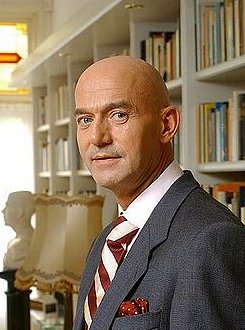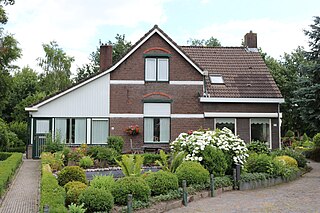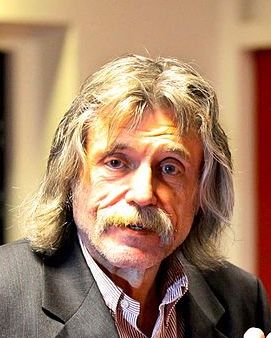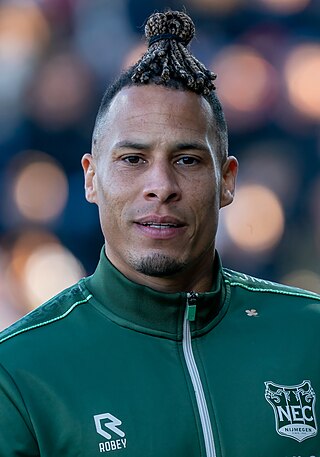
Low Saxon, also known as West Low German are a group of Low German dialects spoken in parts of the Netherlands, northwestern Germany and southern Denmark. It is one of two dialect groups, the other being East Low German.

Wilhelmus Simon Petrus Fortuijn, known as Pim Fortuyn, was a Dutch politician, author, civil servant, businessman, sociologist and academic who founded the party Pim Fortuyn List in 2002.

Drenthe is a province of the Netherlands located in the northeastern part of the country. It is bordered by Overijssel to the south, Friesland to the west, Groningen to the north, and the German state of Lower Saxony to the east. As of January 2023, Drenthe had a population of about 502,000, and a total area of 2,680 km2 (1,030 sq mi).

Harderwijk is a municipality and city of the Netherlands.

Naarden is a city and former municipality in the Gooi region in the province of North Holland, Netherlands. It has been part of the new municipality of Gooise Meren since 2016.

Sinterklaas or Sint-Nicolaas is a legendary figure based on Saint Nicholas, patron saint of children. Other Dutch names for the figure include De Sint, De Goede Sint and De Goedheiligman. Many descendants and cognates of "Sinterklaas" or "Saint Nicholas" in other languages are also used in the Low Countries, nearby regions, and former Dutch colonies.

Theodoor "Theo" van Gogh was a Dutch film director. He directed Submission: Part 1, a short film written by Somali writer and politician Ayaan Hirsi Ali, which criticised the treatment of women in Islam in strong terms. On 2 November 2004, he was murdered by Mohammed Bouyeri, a Dutch-Moroccan Islamist who objected to the film's message. The last film Van Gogh had completed before his murder, 06/05, was a fictional exploration of the assassination of Dutch politician Pim Fortuyn. It was released posthumously in December 2004, a month after Van Gogh's death, and two years after Fortuyn's death.

M. Vasalis, was a Dutch poet and psychiatrist.

Weerdinge is a neighbourhood and former village of Emmen in the Dutch province of Drenthe.

Johannes Gerrit "Johan" Derksen is a Dutch sports journalist and former football player. He played professional football between 1966 and 1978 for six clubs: Go Ahead Eagles, Cambuur, Veendam, HFC Haarlem, SV Meppen and MVV Maastricht. During and after his footballing career, he became a sports journalist, specialising in football. He was the editor-in-chief of Voetbal International, the Netherlands' most prominent football magazine, from 2000 until his retirement in 2013. Derksen was while working at Voetbal International and after his retirement a television football pundit on RTL7's Voetbal International and Veronica Inside on Veronica TV. His current TV talkshow is Vandaag Inside on SBS6.

Koningsdag or King's Day is a national holiday in the Kingdom of the Netherlands. Celebrated on 27 April, the date marks the birth of King Willem-Alexander. When the Dutch monarch is female, the holiday is known as Koninginnedag or Queen's Day and, under Queen Beatrix until 2013, was celebrated on 30 April.

Tjaronn Inteff Chefren Chery is a professional footballer who plays as an attacking midfielder for Eredivisie club NEC on loan from Israeli club Maccabi Haifa. Born in the Netherlands, he represents the Suriname national team.

Augustinus Franciscus Henri Falise was a Dutch sculptor and medailleur. Next to smaller sculptures he designed large monuments of public figures in stone or messing which are still present in many towns in the Netherlands.

De puinhopen van acht jaar Paars is a political non-fiction book released by the Dutch political commentator and aspiring lawmaker Pim Fortuyn in 2002, two months prior to his assassination. In the book, Fortuyn sharply criticizes the then ruling "Purple" coalition government and its direct predecessor on nearly all areas of their policies.

Republicanism in the Netherlands is a movement that strives to abolish the Dutch monarchy and replace it with a republic. The popularity of the organised republican movement that seeks to abolish the monarchy in its entirety has been suggested to be a minority among the people of the Netherlands, according to opinion polls.

Thijs Dallinga is a Dutch professional footballer who plays as a forward for Ligue 1 club Toulouse and the Netherlands national team.

Henricus Adrianus Josephus "Hans" Smolders is a Dutch politician, former professional ice hockey player and entrepreneur.
The Dutch Indoor Athletics Championships is an annual indoor track and field competition organised by the Royal Dutch Athletics Federation, which serves as the national championship for the sport in the Netherlands. Typically held over two to three days in February during the Dutch winter, it was first added to the national calendar in 1969, supplementing the main outdoor Dutch Athletics Championships held in the summer since 1910.

JA21 is a political party in the Netherlands, active in the House of Representatives and Senate. It was founded on 18 December 2020 by Joost Eerdmans and Annabel Nanninga after they left the Forum for Democracy (FVD) on 26 November 2020. The party, affiliated with conservative liberalism, first participated in elections in the 15–17 March 2021 general election.




















